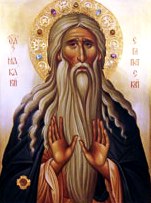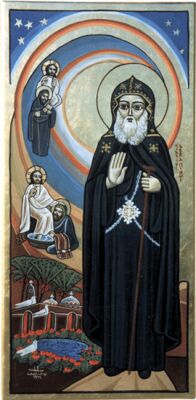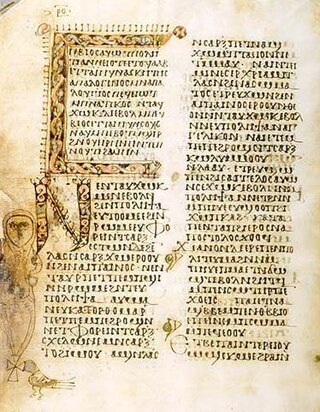Related Research Articles

Anthony the Great was a Christian monk from Egypt, revered since his death as a saint. He is distinguished from other saints named Anthony, such as Anthony of Padua, by various epithets: Anthony of Egypt, Anthony the Abbot, Anthony of the Desert, Anthony the Anchorite, Anthony the Hermit, and Anthony of Thebes. For his importance among the Desert Fathers and to all later Christian monasticism, he is also known as the Father of All Monks. His feast day is celebrated on 17 January among the Eastern Orthodox and Catholic churches and on Tobi 22 in the Coptic calendar.

Pachomius, also known as Saint Pachomius the Great, is generally recognized as the founder of Christian cenobitic monasticism. Coptic churches celebrate his feast day on 9 May, and Eastern Orthodox and Catholic churches mark his feast on 15 May or 28 May. In Lutheranism, he is remembered as a renewer of the church, along with his contemporary, Anthony of Egypt on 17 January.

Moses the Black, also known as Moses the Strong, Moses the Robber, and Moses the Ethiopian, was an ascetic hieromonk in Egypt in the fourth century AD, and a Desert Father. He is highly venerated in the Eastern Orthodox Church and the Oriental Orthodox Church. According to stories about him, he converted from a life of crime to one of asceticism. He is mentioned in Sozomen's Ecclesiastical History, written about 70 years after Moses's death.

Macarius of Egypt was a Christian monk and grazer hermit. He is also known as Macarius the Elder or Macarius the Great.

The Desert Fathers were early Christian hermits and ascetics, who lived primarily in the Scetes desert of the Roman province of Egypt, beginning around the third century AD. The Apophthegmata Patrum is a collection of the wisdom of some of the early desert monks and nuns, in print as Sayings of the Desert Fathers. The first Desert Father was Paul of Thebes, and the most well known was Anthony the Great, who moved to the desert in AD 270–271 and became known as both the father and founder of desert monasticism. By the time Anthony had died in AD 356, thousands of monks and nuns had been drawn to living in the desert following Anthony's example, leading his biographer, Athanasius of Alexandria, to write that "the desert had become a city." The Desert Fathers had a major influence on the development of Christianity.

A skete is a monastic community in Eastern Christianity that allows relative isolation for monks, but also allows for communal services and the safety of shared resources and protection. It is one of four types of early monastic orders, along with the eremitic, lavritic and coenobitic, that became popular during the early formation of the Christian Church.

The Sayings of the Desert Fathers is the name given to various textual collections consisting of stories and sayings attributed to the Desert Fathers from approximately the 5th century AD.

Abba Poemen the Great was a Christian monk and early Desert Father who is the most quoted Abba (Father) in the Apophthegmata Patrum. Abba Poemen was quoted most often for his gift as a spiritual guide, reflected in the name "Poemen" ("Shepherd"), rather than for his asceticism. He is considered a saint in Eastern Christianity. His feast day is August 27 in the Julian calendar.

Desert Mothers is a neologism, coined in feminist theology as an analogy to Desert Fathers, for the ammas or female Christian ascetics living in the desert of Egypt, Palestine, and Syria in the 4th and 5th centuries AD. They typically lived in the monastic communities that began forming during that time, though sometimes they lived as hermits. Monastic communities acted collectively with limited outside relations with lay people. Some ascetics chose to venture into isolated locations to restrict relations with others, deepen spiritual connection, and other ascetic purposes. Other women from that era who influenced the early ascetic or monastic tradition while living outside the desert are also described as Desert Mothers.

Bishoy of Scetis, known in the Coptic Orthodox Church of Alexandria as the Star of the Desert and the Beloved of our Good Savior, was a Coptic Desert Father. He is said to have seen Jesus, and been bodily preserved to the present day via incorruptibility at the Monastery of Saint Bishoy in the Nitrian Desert, Egypt. He is venerated by the Oriental Orthodox Churches and the Eastern Orthodox Church, and is known in the latter under the Greek version of his name, Paisios.
The Asceticon by Abba Isaiah of Scetis is a diverse anthology of essays by an Egyptian Christian monk who left Scetis around 450 AD.
The Enaton was a monastic district in Egypt during the Middle Ages. It lasted into the 15th century, but it was at its height between the 5th and 7th centuries. It takes its name, which means "ninth", from its location at the ninth milestone southwest of Alexandria along the coastal road.

Longinus was the hegumenos of the Enaton, a monastic community outside Alexandria in Roman Egypt. He is the subject of a Sahidic Coptic hagiography, the Life of Saints Longinus and Lucius the Ascetics, and a Sahidic homily, In Honour of Longinus, by Bishop Basil of Oxyrhynchus.
Pherme was the location of a community of ascetic monks in the Nile Delta in Egypt which grew after the 4th century CE as a satellite community of the better known community of Kellia.
Isaiah the Solitary, also known as Isaiah of Gaza, Isaias the Solitary, Abba Isaiah, or possibly also Isaiah of Scetis, was a Christian ascetic and monastic writer known from the Sayings of the Desert Fathers and various Palestinian Miaphysite sources. He is canonized as a saint by the Coptic Orthodox Church, with his feast day on the 11th day of the month Abib (Epip) in the Coptic calendar.
Abba Agathon was an Egyptian Orthodox Christian monk and saint who lived around the 4th century in Scetis, Lower Egypt and was known for his meekness and discernment. He was a disciple of Abba Lot and Abba Poemen and a contemporary of notable Desert Fathers Amun, Macarius, Joseph and Peter. He is venerated as a saint in the Orthodox Church on 2 March. Agathon was one of the Desert Fathers.
AbbaAnoub, also known as Anoub of Scetis or Anoubius, was an Egyptian Eastern Orthodox Christian Saint, ascetic and anchorite who lived during the 4th and 5th centuries in Scetis, Lower Egypt. Abba Anoub is mentioned in the Sayings of the Desert Fathers, also called the Apophthegmata or the Gerontikon. Saint Nikolaj Velimirović says, "Anoubius was one of the great Egyptian monks." Abba Anoub was one of the Desert Fathers.
Or of Nitria was an Egyptian Orthodox Christian ascetic who lived around the 4th century AD in Egypt in Dalga, Nitria, the Thebaid, and in the deserts around Shaina. He is one of the lesser-known Desert Fathers, but is nevertheless regarded as one of the "chief among monks", being "a man who stood out among many of the fathers". He is associated with Theodore and Sisoes the Great. According to Jerome, at one point during his life, Or was the father of "one thousand [cenobitic] monks" in the Egyptian Desert. Or died c. 390.
Euprepius of Egypt was an Egyptian Orthodox Christian monk, ascetic, and saint who lived around the 4th century. All of his recorded sayings exist in the Sayings of the Desert Fathers, and little else is known about him.
References
- ↑ Ward, Benedicta (1984). The sayings of the Desert Fathers: the alphabetical collection. Kalamazoo, MI: Cistercian Publications. ISBN 0-87907-959-2.
- ↑ "Abba Longinus the Great". Wind Ministries. 2018-01-17. Retrieved 2021-11-15.
- ↑ Hoag, Gary (2015-09-07). "Abba Lucius: Work, pray, eat, sleep, care for the poor, and be prayed for – Generosity Monk". Generosity Monk. Retrieved 2021-11-15.